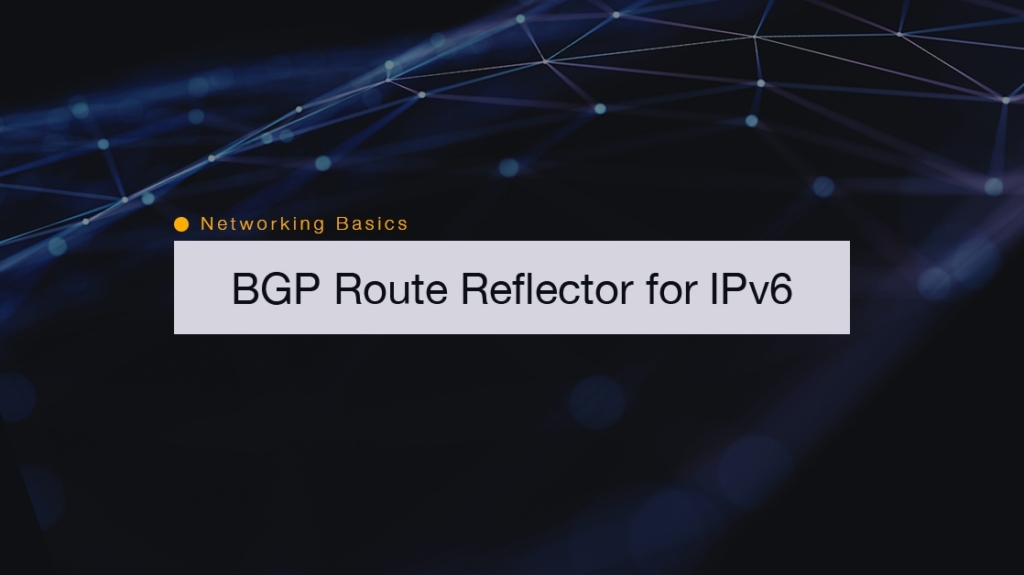Networking Basics: What are BGP Route Reflectors for IPv6

The Quick Definition: Route reflectors are networking routing components specific to border gateway protocol, commonly known as BGP. Route reflectors are an alternative to the full-mesh requirement of internal BGP (IBGP), and act as a focal point for IBGP sessions. Because route reflectors can propagate IBGP routes to other IBGP peers, a full mesh of IBGP peers is not necessary.
Network Block Advertisement
The concept of a route reflector is consistent across IP version 4 as well as 6, but the topology used here refers to IPv6. In the diagram below, the red dotted lines represent external BGP relationships, while the blue dashed lines reflect the internal neighborships within the AAS.

To illustrate the function of route reflectors, identify the network block advertised by R1 to R2. In that process, R2 receives the 2001:db8:1::/48 prefix, which then advertises it to its neighbor connections, in this case R3.
When R3 learns about this route, it is subject to a rule regarding its advertisement: any route/prefix learned from an IBGP neighbor is assumed to be already known by other members of that autonomous system. So, in following that rule, R3 does not share the route with R4 or R5.
The Role of Route Reflectors
If R3 follows the rule and does not advertise the prefix to its internal neighbors, R4 and R5 will not learn it. The purpose of route reflectors is to fix that problem.
To do so, the route reflector simply instructs R3 that, when it receives an advertisement from an IBGP neighbor (in this case, R2), it should break the rule and advertise to the other members of the system. This command to ignore default BGP rules serves to "reflect" the route to locations like R4 that normally would not receive the advertisement.
How to Check for Routes
Before configuring R3 as a route reflector, it's important to check existing state of R4. Given its position in the topology, it should have no existing knowledge of any of the existing blocks or any other external autonomous systems. This indicates its isolated nature given the default rules: when R3 is stopped from forwarding to its neighbors, R4 has no other way of learning the route.
To check any learned routes, bring up the BGP table with show bgp ipv6 unicast. This command returns basic data about any IPv6 routes learned by R4. In this case, the only listing will be indicating knowledge of the block it's part of, but no knowledge of the surrounding autonomous systems. Again, this is due to the BGP defaults that prevent R3 from forwarding to its BGP neighbors.
How to Check for Neighborships
To identify neighbors of R4, enter show bgp ipv6 unicast summary. Now it will return one neighbor entry, R3, and indicates one route learned. Before the route reflector is in place, R4 is missing three additional routes in this summary. Solving this consists of identifying R3 as a route reflector and R4 as a route reflector client.
How to Configure the Route Reflector
First, enter configuration mode with conf t. When prompted for commands, one per line, first enter router bgp 2000. In this case, the 2000 refers to the autonomous system in question. Follow that with address-family ipv6, which enables configuration within that IPv6 address family.
Finally, identify the route reflector client. In the example case, the command would be neighbor 2001:DB8:2:4444:4 route-reflector-client, followed by one last command of end.
The Verification Process
To ensure that R4 is now receiving R3's advertised routes, return to the appropriate portal and reenter the command show bgp ipv6 unicast summary. Now, where the listing once only indicated one route known, it should show four total routes, indicating successful advertisement by R3 as a route reflector.
CBT Nuggets BGP Training
At this time, CBT Nuggets doesn't have training that specifically covers BGP route reflectors in regard to IPv6. However, the following training covers BGP in more detail.
CBT Nuggets trainer Keith Barker addresses BGP Route Reflectors for IPv6 in more detail right here:
delivered to your inbox.
By submitting this form you agree to receive marketing emails from CBT Nuggets and that you have read, understood and are able to consent to our privacy policy.